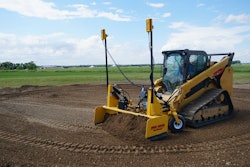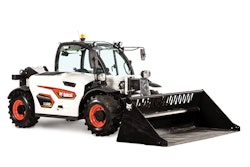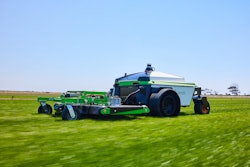
Looking to the future of construction jobsites, many construction equipment manufacturers brought forth electrification concepts as part of their Bauma 2022 displays and presentations.
Among those discussing their latest innovations at the show was Doosan Bobcat. Joel Honeyman, Bobcat’s vice president of global innovation, took the stage at Bauma Forum to present “Leading the Charge: Bobcat T7X transforming the jobsite with sustainable solutions."
"Electric right now is sized well for our categories of equipment, the compact construction equipment," Honeyman said. To go to much bigger equipment than what is currently being done would require a significant leap in technologies, which may mean a different direction, such as hydrogen.
"For what we're doing, the size and the fit just seem to make a lot of sense. We can optimize the package and be able to use electric power," Honeyman said.
Even now, some customers in certain applications are demanding electric equipment.
"We see larger customers like Sunbelt Rentals and then their rental customers who are larger corporations that have ESG mandates,” Honeyman said. “Those ESG mandates are driving the industry toward saying we must provide electric equipment.”
In addition, he cited specifically the state of California, which is continuing to increase regulations on emissions across road and off-road machines.
“When we talk to those entities, they tell us, 'Hey, we're ready to implement it as long as you manufacturers can supply it,'” Honeyman said. “It's the old chicken or the egg argument. I think once we as an industry start to show more of these products, I think we'll start to see more of that shift.”
Although the demand is there on many fronts, he admits that electric is not for everybody.
"We're going to build diesel hydraulic products for many years yet, but there are certain customers that want the advantages that come along with an electric or all-electric platform," Honeyman said.
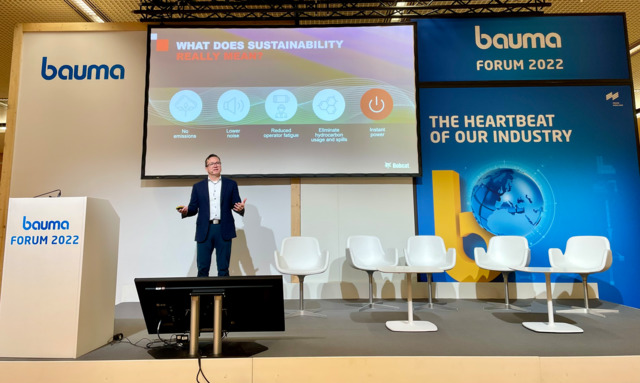 Doosan Bobcat Vice President of Global Innovation Joel Honeyman presented “Leading the Charge: Bobcat T7X transforming the jobsite with sustainable solutions” at Bauma Forum 2022.Bobcat
Doosan Bobcat Vice President of Global Innovation Joel Honeyman presented “Leading the Charge: Bobcat T7X transforming the jobsite with sustainable solutions” at Bauma Forum 2022.Bobcat
All electric?
In January 2022, Bobcat unveiled the first fully electric CTL. Honeyman said the genesis of the concept was simply to electrify a CTL.
“It was like, well, we could take the engine out and put a battery in it, but our engineers sat back and said, 'Well, but what if we got rid of the hydraulics too?' There are people that are doing electric actuation,” Honeyman said. “We had this theory, and it took us about 60 days, and we built a prototype and it worked.”
Two years later and the T7X is now in production with the first commercial units having shipped to Sunbelt Rentals in September.
“It was really about can we do all kinds of different things now with this platform because hydraulics can be inefficient. They generate heat, they leak, and with electric, you don't have that,” he said. “If we use this new technology, if it's available, out there in the marketplace, can we do some different things?"
Advancing the CTL to fully electric allowed Bobcat to consider the application on other platforms. On its compact excavators, Bobcat has released three electric models, the E10e, the E32e, and most recently the E19e. Each is battery-powered but maintains hydraulics for operation. The company has also shown off a prototype E35e that eliminates hydraulic controls.
With the electric excavators and particularly the all-electric T7X, some contractors and competitors feel Bobcat created the platform solely for 'sustainability' and public relations benefits.
“It's a whole package. When we're starting to talk to customers, the emphasis is that it's not just a sustainable machine, it has all these other things that can come along with it that make it a better machine,” Honeyman said. “This is a platform that allows you to do so many different things that we couldn't do with diesel hydraulics.”
He said the T7X offers a more environmentally friendly product that produces zero emissions while at the same time providing operators with increased power and performance by delivering full torque at any time. "Operators who drive these machines are excited about the exceptional power, response time and performance that matches or exceeds the diesel machines they are accustomed to operating, but with no emissions and quiet operation,” Honeyman said.
Depending on the application, the battery can provide up to four hours of continuous operation or longer during intermittent use on the jobsite, enabling a full workday of use. Honeyman noted that he gets a lot of pushback when contractors hear those numbers. However, from his perspective, four hours of continuous operation remains equivalent to an eight-hour workday.
Few operators are running a loader continuously for most applications for four hours. They’re in and out doing other things or idling waiting for other crew members to finish another part of the job.
“The contractor’s mindset is why can I only use it for four hours,” he said. Telematics data shows that nearly a third of a company's machines are idle for a significant portion of an eight-hour workday.
“With an electric machine, what people don't realize is there's no idle time,” Honeyman said. “Every time you let off that joystick, it's not consuming energy.”
Currently, the T7X costs triple that of the current equivalent diesel-hydraulic machine.
"Between fuel and oil changes, general maintenance, downtime with maintenance, and things like that, customers are starting to think about the whole value proposition,” he said. “Prices will come down, but right now it’s expensive. It’s not for everyone, but it is for enough people even at the current price. Now it's up to us to make it more cost-effective.”
Bobcat has a recycling program through its battery manufacturer. Approximately 85% of the battery is recycled.
“We tried to make a fully sustainable process because we know people are sensitive to what happens to all these lithium batteries,” he said, noting that the batteries currently in use have approximately a 10-year lifespan. “These batteries are a long-life type of product. We have a real problem if we're changing batteries every other year.”
Also, recognizing a trend to refurbish existing machines rather than buy new ones, Honeyman noted that actuators and other parts can be refurbished also.
"In some ways, we feel like you could put a new frame and undercarriage underneath and take the battery and the components and put it into a second a second loader potentially in the future, because of the long-term durability and life of those key components,” he said. “That's a theory at this point, but we know that we're getting much longer life on those components than we would be of a hydraulic cylinder.”
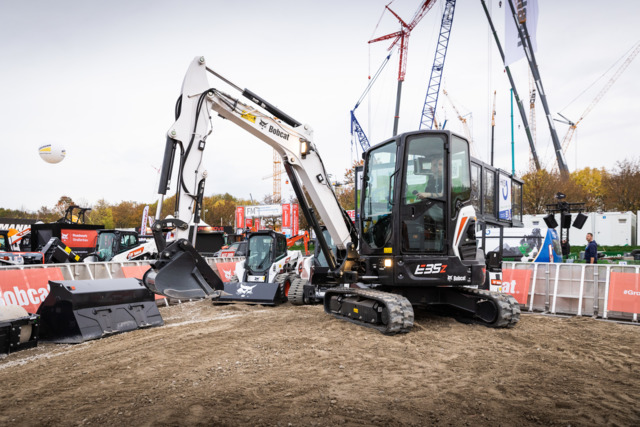 Test models of excavators with integrated sensors to help the machine perform semi-automated tasks like helping the operator with precise grading, leveling, trenching or repetitive tasks such as return to dig are expected to be available in 2023.Bobcat
Test models of excavators with integrated sensors to help the machine perform semi-automated tasks like helping the operator with precise grading, leveling, trenching or repetitive tasks such as return to dig are expected to be available in 2023.Bobcat
What’s next?
Honeyman also shared some insights into projects Bobcat has in development, including machines that feature more electrification and autonomy. He noted that some cab-less versions of machines are farther out on the horizon but are in development.
"It's all about figuring out how you help people get more work done faster and more productively?" Honeyman said. “If there's some solution or technology that we can apply from another industry, somebody we can partner with, that's what we're constantly looking at. What are these other technologies, in these other places that we can combine on this great equipment we've been building for over 60 years and be able to make it better and more productive.”
Concepts closer to release include specific applications for loaders and excavators for autonomous or semi-autonomous operations.
“One of the things we think about is a new operator. Someone puts a new operator in the cab of an excavator, how do you make them productive right away on the site?” Honeyman said. “There are things we can do, not just autonomously, but we can assist the operator to make a new operator productive right away."
Test models of excavators, similar to which was demonstrated at Bauma, are expected to launch in 2023 with integrated sensors to perform semi-automated tasks like precise grading, leveling, trenching or repetitive tasks such as return to dig.
For the system, the hydraulically controlled joysticks are replaced by an intelligent control system and joysticks, which allows Bobcat to customize the machine controls to all levels of operator skill.
In addition, autonomous options are being pursued with some simple lift-and-carry tasks, with Bobcat MaxControl serving as the building block of the platform.
He emphasized that the idea is to not build specialty products but that the new concepts fit existing machines.
“It must connect to and be something simple that we can plug in, and then the operator can still use the machine as they intended if they would like to without that new technology,” Honeyman said.
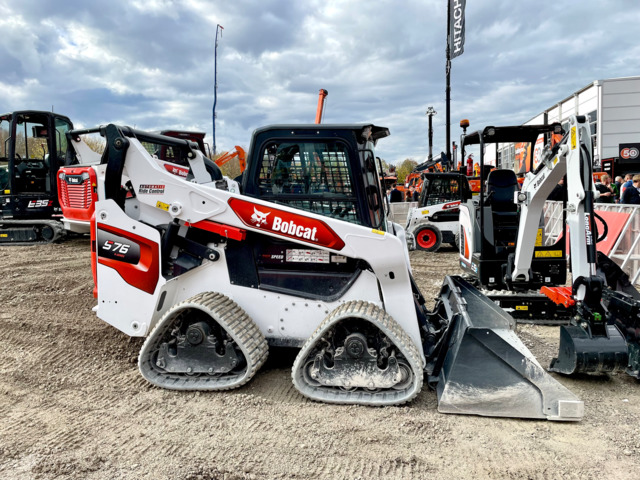 Quad tracks are common in some different applications, from larger agriculture equipment and some other utility vehicles. Bobcat is taking the wheels off a skid steer and putting quads on it providing better flotation and climbing ability in many conditions.Bobcat
Quad tracks are common in some different applications, from larger agriculture equipment and some other utility vehicles. Bobcat is taking the wheels off a skid steer and putting quads on it providing better flotation and climbing ability in many conditions.Bobcat


